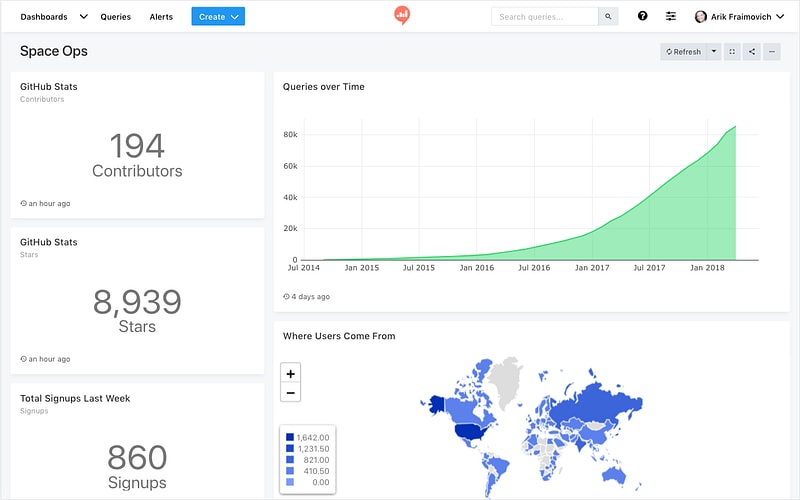When I wrote the blog post announcing the founding of the Redash company, I was naive enough to believe that I would write regular updates about the process of building Redash as a product and a company. Silly me. Turns out it's a full-time job and then some to build a product, bootstrap a company and grow a team. Something had to give; and one such thing was regular updates about the process. So much has happened by now that one article could hardly cover it all. But with 2018 recently concluded, here is my attempt to summarize the last twelve months and take a peek at what's to come.
On its surface, Redash's trajectory in 2018 went like previous years: we added users and customers, grew our revenues, and made the product better than ever. But there was one big difference as we entered 2018: Redash became a team effort.
Until late-2017, Redash was a one-man operation. It became a group of three at the start of 2018. And now for 2019 there are six of us. What enabled this team growth was our customers. As before, we haven’t taken any external funding. To all our past and present customers: thank you 🙏
While we started as a team of 3 in 2018, we are starting 2019 as a team of 6. What enabled this team growth was our customers.
As Redash matured as a company, the product also matured dramatically in 2018. We had three major releases (v4, v5 and v6) that included:
- New UI and better UX
- Dynamic dashboard layouts
- Tagging and Favorites
- Parameters UI improvements
- More visualizations
- More data sources

Plans for 2019
Team Effort
As the team grows, we're building procedures that keep Redash a fun and productive place to work and (importantly) make me redundant to the day to day operations of the company. This will improve team velocity, promote greater stability for our customers, and free my time to focus on more strategic projects.
Even more interactive dashboards and queries
In the releases we made in 2018, we improved the UI for parameters significantly. In 2019 we’re going to finish this effort by adding a few more needed capabilities to parameters (optional parameters, multiple select, better support in dashboards) and by making parameters available everywhere (read only users, shared dashboards, embeds).
Better Permissions Model
Once we have the ability to safely run parameterized queries, we can finally upgrade the Redash permission model and make it more user friendly. The goal is to augment the current model (if you have access to the data source, you have access to the query/dashboard) with a Google Drive like model, where you can assign permissions to individual users or groups on the content level.
Coupled with the improved parameters support mentioned above, Redash in 2019 will reach further and empower more people inside your organizations.
Technical Progress
This year, we plan to conclude our migration to React that began in 2018. This should make it easier to add features and interface with our open-source community. We will also continue to improve the testing story around Redash (thanks Cypress and Percy!). All this will allow us to release more often with greater confidence.
Community
We recently invited nine members from the user community to become Redash maintainers. In 2019, we want to improve our coordination with maintainers and clean up our backlog of Pull Requests.
More Guides and Resources
One thing we neglected in 2018 was to produce up-to-date documentation and usage examples. We want to change this in 2019, but we would also appreciate your feedback! If you have any interesting uses of Redash, we urge you to share them. The forum is a great venue for this.
These are our plans for now. It’s known that no plan survives first contact, so we hope to still surprise you (and ourselves 😅) with some of what we will achieve in 2019. 🍾





Top comments (2)
Awesome. We want to be leveraging redash more. We've been members since mid-2017 and it's been exciting to the improvements from your one-person team to six. I think our/my biggest blocker is SQL proficiency..
...which you would know since you've had to answer so many of my questions! 😅
I hope that "Become SQL master" is on your 2019 resolutions list 😉My appreciation (and knowledge) of SQL grew a lot during the last 5 years since I started working on Redash.
But we are aware of this limitation, and the short term improvement we're introducing is improved parameters support in every release. This allows for those who know SQL in the organization to produce more interactive queries and dashboards, so a single dashboard/query will be useful for variety of use cases.
The longer term solution is to allow for some exploration of the data in an interactive manner without writing queries. This is a harder one to tackle. Mostly because usually the database schema isn't organized that well, so you have to resort to writing SQL anyway... But we have interesting ideas around this, and will eventually get there.
Of course, any feedback on how to make Redash more welcoming to less SQL proficient users is welcome!
Oh, and don't tell anyone, but I actually like SQL questions. It's like puzzles. :)